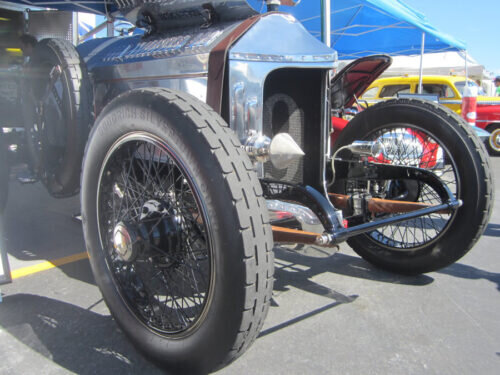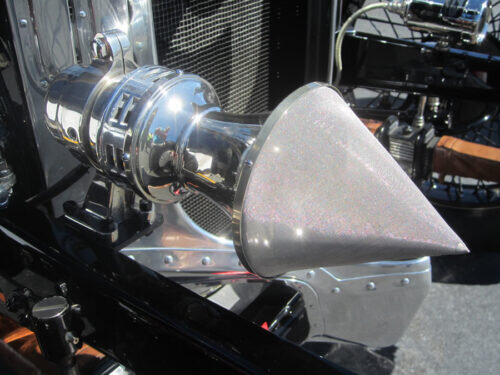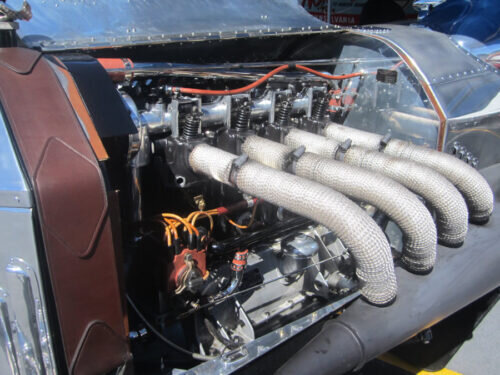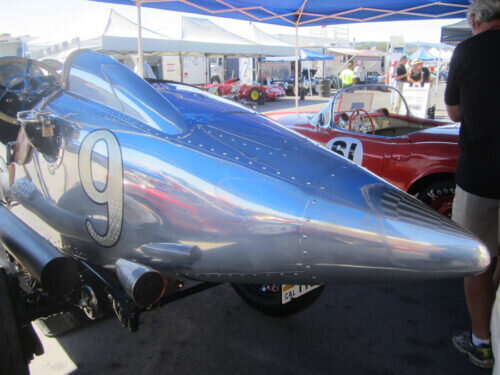Monterey Historic Races: 1917 Hall-Scott Race Car
At the Monterey Historics, this beautiful aluminum race car stopped us in our tracks... This stunning 1917 Hall-Scott race car was filled with fine craftsmanship, and was accompanied by thorough history. "Elbert Hall originally established his company in 1905 to build automobiles. This was wiped out by the earthquake of 1906, but he did design an automobile in 1907. In 1909 Hall and Scott joined forces and formed the Hall-Scott Engine Co. of San Francisco.
This stunning 1917 Hall-Scott race car was filled with fine craftsmanship, and was accompanied by thorough history. "Elbert Hall originally established his company in 1905 to build automobiles. This was wiped out by the earthquake of 1906, but he did design an automobile in 1907. In 1909 Hall and Scott joined forces and formed the Hall-Scott Engine Co. of San Francisco. The company built four and six cylinder engines for World War I Army Air Corps biplanes. Elbert Hall conducted research work for Fred Duesenberg and worked on high performance engines for Harry Miller. In late 1916, Colonel Hall of Hall-Scott designed a 4-cylinder race car with an all aluminum body to compete in the Vanderbilt Cup Race of 1917.
The company built four and six cylinder engines for World War I Army Air Corps biplanes. Elbert Hall conducted research work for Fred Duesenberg and worked on high performance engines for Harry Miller. In late 1916, Colonel Hall of Hall-Scott designed a 4-cylinder race car with an all aluminum body to compete in the Vanderbilt Cup Race of 1917. The 9914cc 4-cylinder aircraft engine developed 110hp at 1300 rpm with 428 lbs of torque (coincidentally the same torque as a Dodge Viper). This engine was to be mounted in a 1917 Reo frame and running gear. The Hall-Scott was to have a top speed of close to 100 mph. The Reo was selected due to its inner engine frame to accommodate an extremely tall Hall-Scott aircraft engine.
The 9914cc 4-cylinder aircraft engine developed 110hp at 1300 rpm with 428 lbs of torque (coincidentally the same torque as a Dodge Viper). This engine was to be mounted in a 1917 Reo frame and running gear. The Hall-Scott was to have a top speed of close to 100 mph. The Reo was selected due to its inner engine frame to accommodate an extremely tall Hall-Scott aircraft engine. The reconstruction of this car has taken 5 and 1/2 years to complete. The car was shown at Pebble Beach and ran in the Monterey Historics at Laguna Seca, Goodwood Festival of Speed and Speed Festival of San Diego.
The reconstruction of this car has taken 5 and 1/2 years to complete. The car was shown at Pebble Beach and ran in the Monterey Historics at Laguna Seca, Goodwood Festival of Speed and Speed Festival of San Diego. The aluminum body, with its thousands of rivets, is highly polished and has maintained the exhaust system of the original design plus extensive use of leather belts. Special thanks to its builder and designer, Tom Batchelor or Reno, Nevada and Dennis Webb of Anaheim, California for constructing the aluminum body."
The aluminum body, with its thousands of rivets, is highly polished and has maintained the exhaust system of the original design plus extensive use of leather belts. Special thanks to its builder and designer, Tom Batchelor or Reno, Nevada and Dennis Webb of Anaheim, California for constructing the aluminum body." The tail end of this race car is just a small example of the craftsmanship involved in the construction of this car. The rivets remind us of the airplanes of this era, and the shape is a great experiment in aerodynamics. Best of all, this superbly restored Hall-Scott is exactly where it belongs - on the track - proving its worth nearly 100 years after its introduction.
The tail end of this race car is just a small example of the craftsmanship involved in the construction of this car. The rivets remind us of the airplanes of this era, and the shape is a great experiment in aerodynamics. Best of all, this superbly restored Hall-Scott is exactly where it belongs - on the track - proving its worth nearly 100 years after its introduction.
